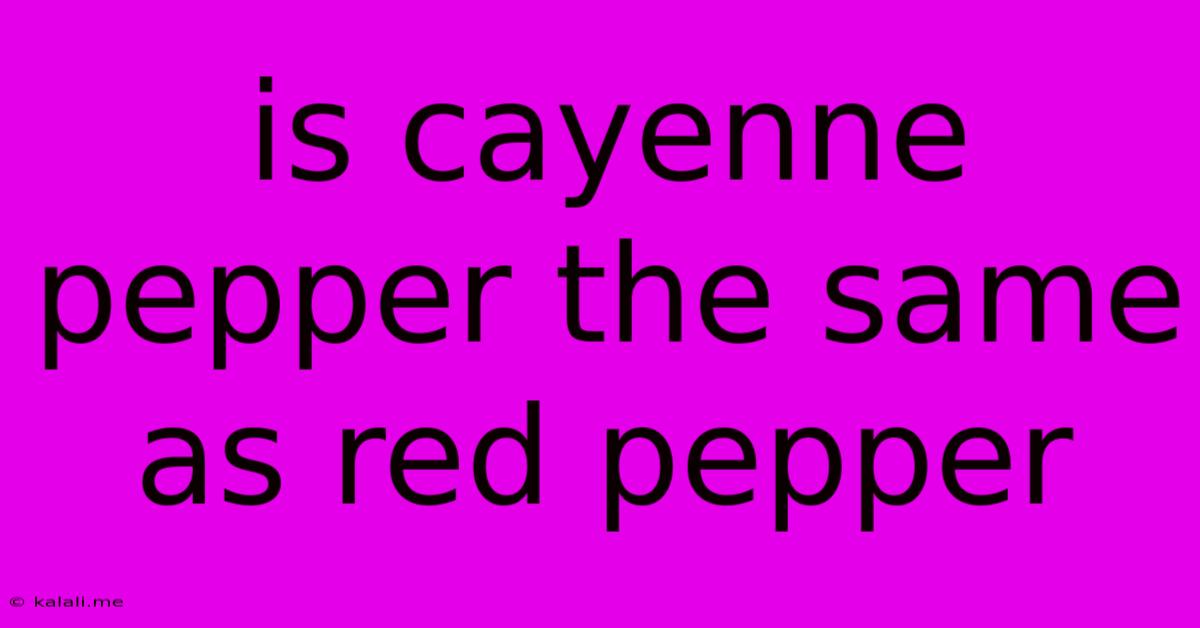Is Cayenne Pepper The Same As Red Pepper
Kalali
May 24, 2025 · 3 min read

Table of Contents
Is Cayenne Pepper the Same as Red Pepper? Unpacking the Spicy Truth
Are cayenne pepper and red pepper the same thing? While both bring heat to the kitchen, the answer is nuanced. This article delves into the botanical similarities and key differences between these fiery peppers, exploring their heat levels, flavor profiles, and culinary uses. Understanding these distinctions will elevate your cooking and spice knowledge.
Cayenne pepper and red pepper are often used interchangeably, leading to confusion. However, "red pepper" is a broad term encompassing a vast family of Capsicum species, while cayenne pepper refers to a specific type within that family. Think of "red pepper" as an umbrella term, and cayenne pepper as one specific pepper under that umbrella.
Understanding the Capsicum Family
The Capsicum genus boasts a wide array of peppers, varying dramatically in size, shape, color, and – most importantly – heat. This family includes sweet peppers like bell peppers, along with various chili peppers, ranging from mild to intensely hot. Both cayenne pepper and many other "red peppers" belong to this diverse family.
Cayenne Pepper: A Detailed Look
Cayenne pepper is a specific type of chili pepper known for its elongated shape, slender size, and vibrant red color when ripe. Its defining characteristic is its significant heat, stemming from its high capsaicin content. Capsaicin is the chemical compound responsible for the burning sensation we experience when consuming chili peppers. The Scoville Heat Unit (SHU) scale measures capsaicin levels, and cayenne peppers typically range from 30,000 to 50,000 SHU.
Red Pepper: A Broad Spectrum
The term "red pepper" is far more encompassing. It can refer to a multitude of chili peppers, including but not limited to:
- Bell peppers: These are technically sweet peppers within the Capsicum family and lack capsaicin, meaning they are not spicy at all. They come in various colors, including red.
- Jalapeños: These are relatively mild chili peppers often used in Mexican cuisine.
- Serranos: These are spicier than jalapeños, boasting a sharper, more intense heat.
- Poblanos: These are larger, milder peppers often used in stuffed peppers.
- Other chili varieties: Numerous other chili peppers exist worldwide, all falling under the "red pepper" umbrella if ripe and exhibiting a red color.
Key Differences: Heat and Flavor
The most significant difference between cayenne pepper and the broader term "red pepper" lies in their heat levels and flavor profiles. Cayenne peppers possess a consistent, medium-to-high level of heat, along with a slightly bitter and fruity flavor. Other "red peppers," however, can range from mild and sweet (like bell peppers) to extremely hot (like habaneros). Their flavors also vary greatly, depending on the specific type.
Culinary Applications: A World of Spice
Both cayenne pepper and other red peppers find their place in diverse cuisines. Cayenne pepper is frequently used as a spice, added to dishes to provide a consistent level of heat. It's a common ingredient in chili powders, hot sauces, and various spice blends. Other red peppers find their application in a far broader spectrum, from fresh additions to salads and salsas to the star of many chili recipes.
In summary, cayenne pepper is a specific type of chili pepper within the large family of "red peppers." While both contribute heat and flavor, the scope of "red pepper" is vastly wider, encompassing a range of peppers with diverse heat levels and taste profiles. Understanding this distinction is crucial for both culinary exploration and precise recipe execution.
Latest Posts
Latest Posts
-
Why Did Jesus Call Simon Peter
May 24, 2025
-
How To Tear Down A Chimney
May 24, 2025
-
You Might Not Like Me Using This Word
May 24, 2025
-
How To Make Mouse Click Silent
May 24, 2025
-
How Fast Does A Comet Move
May 24, 2025
Related Post
Thank you for visiting our website which covers about Is Cayenne Pepper The Same As Red Pepper . We hope the information provided has been useful to you. Feel free to contact us if you have any questions or need further assistance. See you next time and don't miss to bookmark.